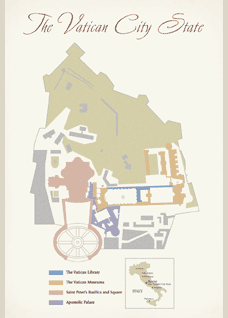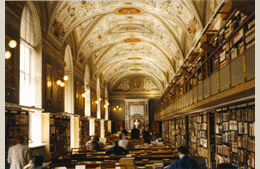|
The
Vatican Library
 The
Vatican Library, or "BAV" (Biblioteca Apostolica
Vaticana) has been accessible only to church officials and
scholars since its inception in 1451 by Pope Nicholas V
for the "convenience of the learned." Located
in the Cortile Del Belvedere in Vatican City, it is one
of the oldest libraries in existence. The
Vatican Library, or "BAV" (Biblioteca Apostolica
Vaticana) has been accessible only to church officials and
scholars since its inception in 1451 by Pope Nicholas V
for the "convenience of the learned." Located
in the Cortile Del Belvedere in Vatican City, it is one
of the oldest libraries in existence.
The
BAV contains 1,600,000 printed works (including 8,000 incunabula);
some 75,000 Latin, Greek, Arabic, Hebrew, Persian, Ethiopian,
Syriac, unique and illuminated manuscripts from the second
century A.D. onward; 65,000 archival volumes in twenty-three
collections, and 40,000 prints, engravings, etchings, drawings
and maps. While many of these works are religious in nature,
secular works in the liberal arts and sciences make up the
majority of the library's collection. Among these works
are the Palatine Virgil, the love letters of King Henry
VIII to Anne Boleyn, autographed works of the Italian poet
Petrarch, original working-sketches and letters of Michelangelo,
and Botticelli's illustrations of Dante's Divine Comedy.
Throughout
the Renaissance, the Vatican Library acted as a catalyst
for scientific and geographic advancement. Within the library's
walls are ancient timepieces, scientific instruments, navigational
tools, stellar and terrestrial globes, coveted maps of the
old world and, of course, intricate maps of the new world
(Christopher Columbus was born in 1451, the year of the
library's founding). The library also contains many rare
works illustrating extinct birds, animals, flowers, plants,
and insects.
 The
BAV has also collected priceless works of art. There are
over 330,000 ancient Greek, Roman, and papal coins as well
as sacred and secular artifacts in the library, including
ceramics, crystal, gold, glass, sculpture, ivories, silver,
and other media. Many of these treasures are gifts from
kings and pontiffs to the library. The BAV's art collection
extends beyond the western world, and features priceless
Egyptian, Near Eastern, Asian and South American treasures
and artifacts. The
BAV has also collected priceless works of art. There are
over 330,000 ancient Greek, Roman, and papal coins as well
as sacred and secular artifacts in the library, including
ceramics, crystal, gold, glass, sculpture, ivories, silver,
and other media. Many of these treasures are gifts from
kings and pontiffs to the library. The BAV's art collection
extends beyond the western world, and features priceless
Egyptian, Near Eastern, Asian and South American treasures
and artifacts.
|